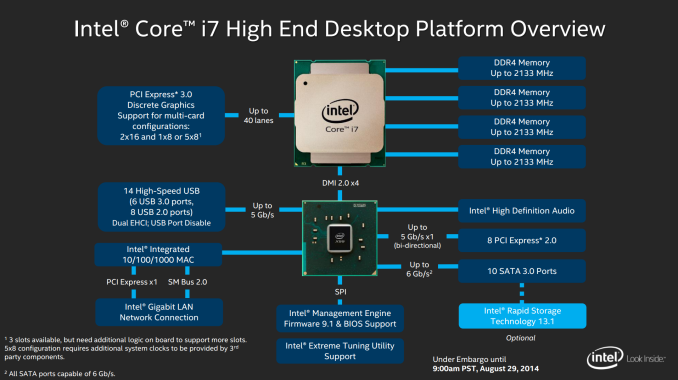The Intel Haswell-E X99 Motherboard Roundup with ASUS, GIGABYTE, ASRock and MSI
by Ian Cutress on September 25, 2014 11:30 AM ESTX99 Conclusion
Back in the early 2000s, some motherboard manufacturers had trouble getting the basics to work. Fast forward ten years and the basics are easily pushed aside – motherboard manufacturers now end up attempting to differentiate with new features and the user experience. At some point, motherboard design becomes less about electrical engineering and more about psychological interaction between the user and the product. We end up saying ‘they all work out of the box, but it is the added bits that make or break the experience’.
X99 as a platform has been anticipated for a long while. Putting the fact that every user has access to six or eight cores aside, the fact that X79 has been around for so long and lacked the modern features means that some will happily upgrade despite the cost. We get a full set of SATA 6 Gbps ports, more USB 3.0 ports, Thunderbolt support, DDR4 and PCIe storage. X99 also brings the first motherboards with tri-antenna 802.11ac, which is exciting in itself. Haswell-E gives a chance for all the motherboard manufacturers to stretch their engineering departments into creating something new for the high end, and it is interesting to see which manufacturers grasp that opportunity.
From our reviews today, there exists three clear markets.
The ASUS X99-Deluxe is aimed at the i7-5960X buyer who wants everything and they want it today. By only releasing two motherboards for X99 launch, both $400 and up, ASUS clearly wants to make its mark on the high-end.
On the opposite side of the scale is the MSI X99S SLI Plus at $230, which wants to hoover up all the i7-5820K market for those limited on budget by providing something cheap but works well. Sure, it does not get the bells and whistles of the high end stuff aimed at gamers and overclockers, but it makes sense for some get-up and go.
In the middle, in that $280-$350 range, is somewhat of a no-man’s land. These motherboards have to offer something more than the base but cannot be too extravagant. For the ASRock X99 WS, this means workstation like features at a non-workstation like price. Unfortunately beyond RDIMM and ECC support, along with 1U height limitations, a vPro enabled NIC and large heatsinks, it feels uncharacteristic of ASRock by not having plenty of extra usable functionality for its price. The GIGABYTE X99-UD7 WiFi performs better by being at the top of the Ultra Durable line and playing around with M.2 WiFi, extra durability in the sockets and hole spacing, using USB 3.0 hubs to expand functionality without losing PCIe lanes and aiming at four-way graphics GPU setups up and down its product line. Then the sleeved SATA cables are a nice touch too.
Haswell-E is still young. The processors, X99 and DDR4 were eventually rushed to market due to a release date change which means that manufacturers are still playing around trying to optimize settings. This is exemplified most in rush to improve DRAM verification, with not all memory kits being verified on all motherboards as of yet. This comes in conjunction with some motherboards reporting issues with the high end kits resulting in BIOS updates coming thick and fast. For those users who want super fast memory, it might make sense to wait a month until this is all sorted out. X99 is not going anywhere soon.
In the end, the market for X99 is small in comparison to the mainstream market, but it does represent the consumer halo of awesome PCs and ultimate PC builds. The extreme processor platform will always be for the server crowd who demand performance, and it ends up being positive marketing for those who deal with the consumer cut-offs. The question to answer is this: we were as excited moving from X58 to X79, but we eventually got frustrated with X79 due to Z97's feature set. How long will it be before X99 feels old?











62 Comments
View All Comments
nathanddrews - Thursday, September 25, 2014 - link
So which system will serve as the new 2015 gaming review platform? Also, OC + GTX 980 OC Quad-SLI? ;-)techxx - Thursday, September 25, 2014 - link
Why are these things so damn expensive? I was hoping for a Mini-ITX for low $100s.Flunk - Thursday, September 25, 2014 - link
X99 is the workstation/enthusiate platform. You're not likely to see any mini-ITX boards at all, certainly not for $100. Maybe you're thinking of Z97?techxx - Thursday, September 25, 2014 - link
Was right about to correct my post. Yup.Ian Cutress - Thursday, September 25, 2014 - link
We recently reviewed three Z97 mini-ITX at $140 :) http://anandtech.com/show/8276/z97-miniitx-review-...BubbaJoe TBoneMalone - Thursday, September 25, 2014 - link
ASUS Shadowcat x99 mini-itx with usb 3.1 in the works -> http://rog.asus.com/325712014/asus-gaming-motherbo...korben44 - Thursday, September 25, 2014 - link
Sorry, but that Shadowcat is not X99... X99 CPUs do not have onboard graphics chips...editorsorgtfo - Sunday, May 17, 2015 - link
ASRock X99E-ITX/ac but at around 300.just4U - Thursday, September 25, 2014 - link
I'd like to see what they have on the go for MATX.y2kBug - Thursday, September 25, 2014 - link
It's nice to see that these motherboards support Xeon CPUs. Though, does anybody know if Haswell-E Xeons are overclockable? Probably not, but it is nice to know that you can upgrade your machine with 8-Core Xeon in a few years cheaply when big data centers start getting rid of them while upgrading to something new (similar to what is happening to Nehalem/Westmere Xeons now).